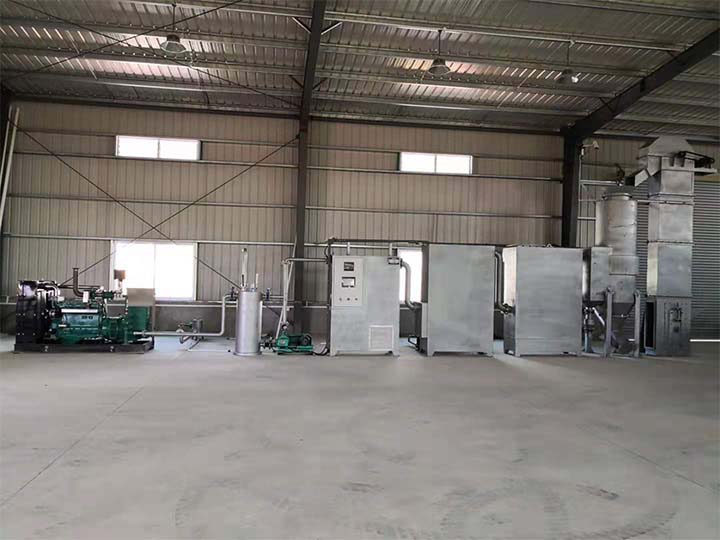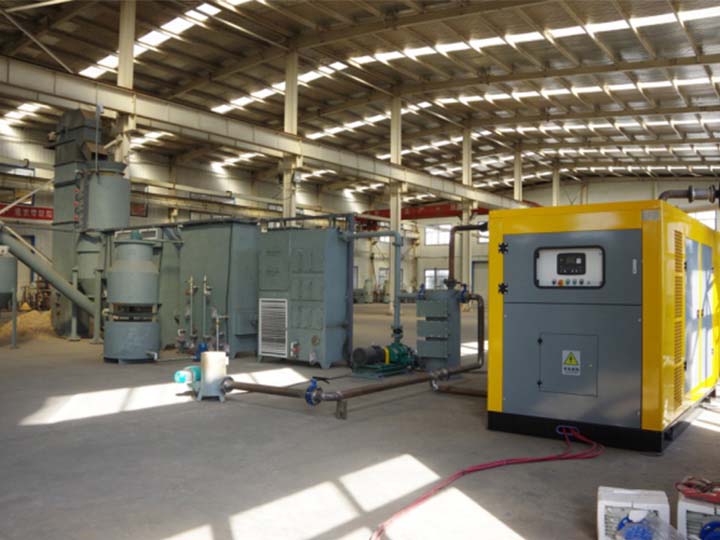The gas produced by the biomass gas stove belongs to the green new energy and has strong vitality. Since the raw materials are crop straw, forest waste, edible fungus residue, cattle, sheep and livestock manure and all combustible substances, it is an inexhaustible renewable resource. Each farmer only needs 3-5 kilograms of plant raw materials per day to solve all-day energy consumption (cooking, heating, showering), and burning like liquefied petroleum gas. It can replace traditional firewood stoves and liquefied petroleum gas and completely change the smoky lifestyle in rural.
The amount of solid biomass available in most rural areas is huge, mainly agricultural waste and wood waste. The distribution of biomass is scattered, it is difficult to collect and transport, and it is difficult to adopt large-scale combustion technology, so small and medium-scale biomass gasification power generation technology has unique advantages.
The working principle of biomass gasifier
The reaction process of different biomass is also different. Common gasification furnace reactions can be divided into oxidation layer, reduction layer, cracking layer and drying layer.
The oxidation zone and the reduction zone are collectively called the gasification zone, and the gasification reaction is mainly carried out here. The cracking zone and the drying zone are collectively referred to as the fuel preparation zone.

- Oxidation reaction: The main reaction of biomass in the oxide layer is oxidation reaction. The gasification agent is introduced from the lower part of the grate and enters the oxide layer after the ash layer absorbs heat. Here, the high-temperature carbon undergoes a combustion reaction to generate a large amount of carbon dioxide. Release heat, the temperature can reach 1000~1300 degrees Celsius. The combustion in the oxide layer is an exothermic reaction, and this part of the reaction heat provides a heat source for the reduction reaction of the reducing layer, cracking and drying of materials.
- Reduction reaction: The carbon dioxide and carbon generated in the oxide layer undergo a reduction reaction with water vapor.
- Cracking reaction zone: The hot gas generated in the oxidation zone and the reduction zone passes through the cracking zone during the upward process to heat the biomass, so that the biomass in the cracking zone undergoes a cracking reaction.
- Dry area: After the oxidation layer, the reduction layer and the pyrolysis reaction zone, the gas products rise to this zone, heating the biomass raw material, so that the moisture in the raw material evaporates, absorbs heat, and lowers the production temperature. The outlet temperature of the biomass gasification furnace is generally 100~ 300°C.
Product performance of the biomass gasification
- No need any additives: just take any flammable substance and use it.
- Environmental protection and energy saving: 2.1m3 of gas can be produced per kilogram of fuel, and no smoke and dust will be emitted during use. Add 2-3 kilograms of fuel each time, and the gas can be used continuously for 90-180 minutes.
- Safety and environmental protection: low working pressure, no exhaust gas, no danger of explosion, no personal injury caused by exhaust gas discharged from coal burning, and environmental protection.
- Service life: Users can disassemble and repair within 60 minutes, and the service life is 10-15 years.

Product advantages of the biomass syngas power plant
- Super powerful conversion system, low start-up heat transfer temperature and fast heat transfer speed.
- The installation cost is low, and the heating is safe: the equipment is universal, the original heating equipment is not changed, the pipes and radiators are universal, and the water circulation is used to achieve the heating effect;
- The heating speed is fast, the heating area can reach 60-500 square meters, the heating is 24 hours, and the service life is long.
- A wide range of raw materials (grain husks, corn stalks, rice stalks, wheat stalks, sesame stalks, peanut husks, branches, sawdust, weeds, etc.) all biomass combustible agricultural and forest wastes.
- Wide application: wide application: cooking and cooking, boiling water for heating, township enterprises and restaurants, urban stalls, cooking livestock food, showering, warming hotbeds, etc.
